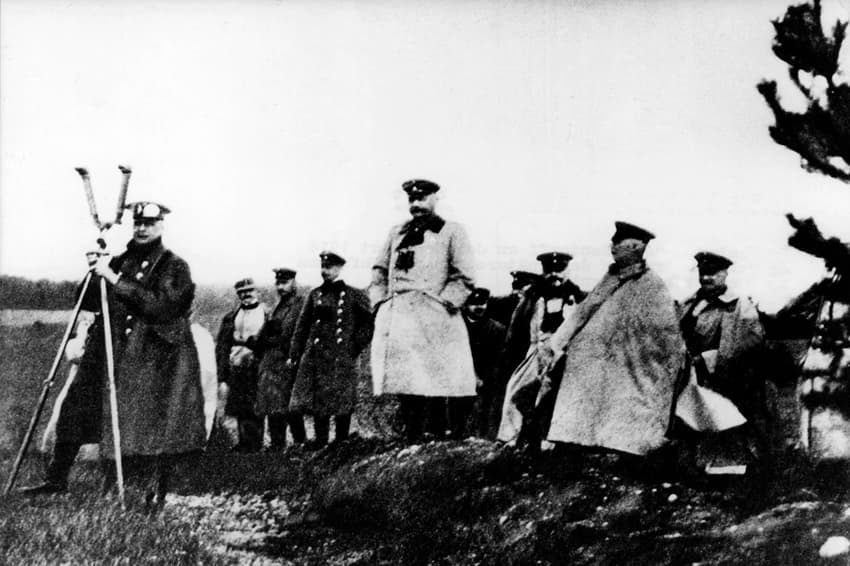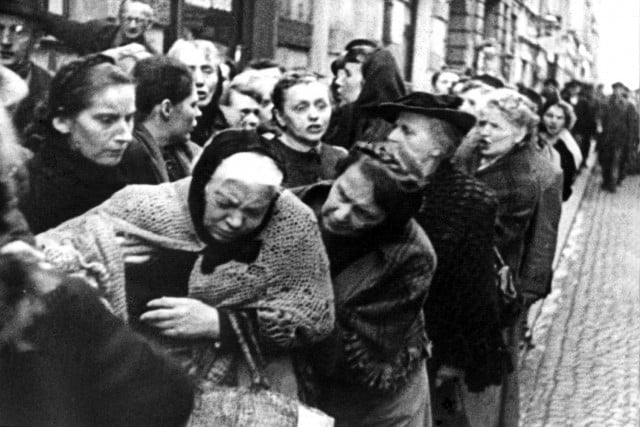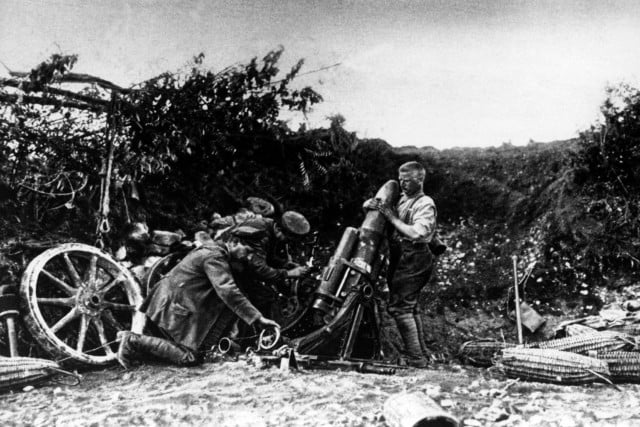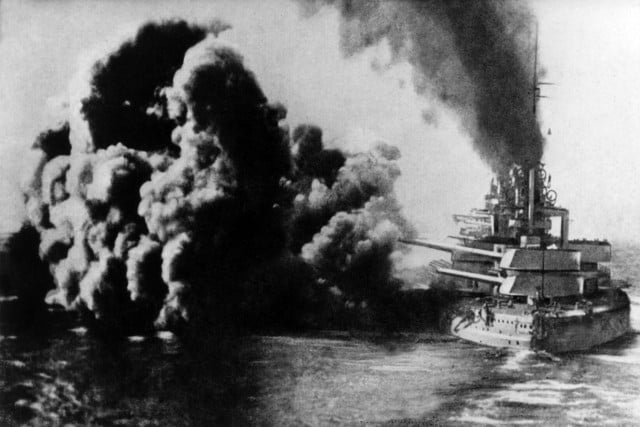What led to the German collapse in WWI?

November marks 100 years since the end of World War I. What were its major battles, and how did they lead to the defeat of Germany - initially poised for victory - in the final days of war?
World War I's deadliest and most decisive battles were fought in Europe, on the Western Front, slashing through the muddy fields of northern France and Belgium.
Germany allied with Austria-Hungary and Italy against Britain, France and Russia in the war which stretched from July 28th 1914 to November 11th 1918.
The German cost of involvement
The German government saw entering the war as a way to end ongoing disputes they had with Britain, France and Russia. The Foreign Minister of the time, Bernard von Bülow, had said - amid rising nationalism -that going to war was needed to "secure our place under the sun."
Kaiser Wilhelm II hoped that the war would unite the public, and lessen the threat he saw posed by the quick growth of the Social Democratic Party (SPD) of Germany, which was critical of the Kaiser.
Yet it soon became apparent that Germany wasn't prepared for the war, which raged on for four years. The German economy was dependent on imports of food and raw materials, which were severely limited during the British blockade of Germany which lasted throughout the war, until 1919.
Germans became used to rationing for what little food supplies they had, turning to mass slaughter of pigs or at one point even eating animal feed during the so-called Turnip Winter of 1916-1917 when people were desperate to survive.
In December 1918, the German Board of Public Health stated that nearly 800,000 German civilians had died from starvation and disease caused by the blockade.

An older woman collapses while waiting in line for food in Frankfurt am Main in 1916. Photo: DPA
A halted German attempt
The front line stretched more than 700 kilometres, from the North Sea to France's Vosges mountains near Switzerland.
But the Great War also raged on Russian, Balkan and Italian fronts, and spread rapidly to the Middle East, colonial Africa and Asia, where Japan sided with the Allies to seize German islands in 1914.
The United States intervened late - but decisively - in 1917, drawing in several Latin American nations. In the aftermath the Middle East was entirely redrawn as the Ottoman empire collapsed.
Just weeks after war was declared, German troops marched into Belgium on August 17th, 1914, crushing defences and driving a flood of refugees before them as they advanced on Paris.
As France's government fled southwest to Bordeaux, the French were driven back and suffered heavy losses. Some 27,000 soldiers died on the single day of August 22nd, the deadliest in French military history.
The French General Joseph Joffre regrouped his retreating armies to fight the First Battle of the Marne on September 5-12nd, which halted the German advance.

A heavy German trench mortar being prepared for use. Photo: DPA
But the extent of losses this early in the conflict - more than half a million already - ruled out any chance of compromise.
Troops burrowed down into their trenches to try to shield themselves from a hail of artillery fire.
From that point, the conflict became a three-year war of attrition that produced little tangible result despite repeated, bloody attempts by both sides to break the stalemate.
Eastern Front: Difficult terrain
Fighting played out quite differently on the less populated Eastern Front where sprawling expanses made trench warfare impossible.
Immediately at the outbreak of war, the Ottoman empire - allied with Germany and Austria-Hungary - closed the Bosphorus Strait to isolate Russia, which was fighting alongside Britain and France.
Russia launched a major offensive into East Prussia on August 15th but its campaign ended the following month with two heavy defeats at Tannenberg and the Mazurian Lakes.
Russia, where the state was on the verge of collapse, began a shambolic eastward retreat which continued until the Bolshevik Revolution of 1917 and the humiliating treaty of Brest-Litovsk in March 1918, which stripped Moscow of its western territories and a third of its population.
Verdun and the Somme: Not in Germany's favour
On the Western Front, 1915 saw a string of bloody but undecisive offensives, marked by the large-scale deployment of modern weapons, including machine guns and heavy artillery. German forces made the first ever use of poison gas near Ypres, in Belgium.
In the spring, the Allies - led on the British side by a young Winston Churchill - launched a naval and ground campaign in the Dardanelles to prise open the Bosphorus Strait.
The battle, which ended in bitter defeat for the Allies, left an enduring mark in Australia and New Zealand whose young soldiers stood out for their courage.
Russia enjoyed more success against Ottoman forces, repelling them in the Caucasus and Armenia. But hundreds of thousands of Armenians were to die in mass killings between 1915 and 1917, accused of siding with the Russians in the fighting.
British and German naval forces meanwhile faced off in the North Sea and Atlantic Ocean. To counter a maritime blockade, Germany in 1915 launched a ruthless campaign of submarine warfare which came to a head in 1917.

A German capital ship firing a broadside during the legendary battle of Skagerrak during May/June 1916. Photo: DPA
As a strategic move this proved conclusive, but not in Germany's favour: outraged by the torpedoing of neutral ships or those carrying American citizens, the United States entered the war in 1917.
But 1916 went down in history as the year of Verdun, the defining battle of the war for the French, and the Somme, which holds the same place in British memory.
The Germans launched the initial offensive at Verdun in February with French forces managing to contain their advance, at a huge cost with nearly 800,000 dead and wounded.
In July, to take the strain off Verdun, British forces launched the biggest battle of the war, near the Somme river, which left 1.2 million men dead, wounded or missing, for minimal territorial gains.
In the Middle East, British forces invaded Turkish territory from the south in 1914 and went on to encourage the Arab population to rise up against their Ottoman rulers.
In 1916, Britain and France struck the Sykes-Picot accord under which they began carving out the shape of the future Middle East.
The German collapse
In July, 1917, the British launched a huge offensive in Flanders, Belgium. France had done the same in April at the Chemin des Dames, a crushing failure that lead to mutinies in the French army.
In October, Italian forces suffered a disastrous defeat at Caporetto, leaving 300,000 prisoners in the hands of German and Austrian forces.
In December, meanwhile, British general Edmund Allenby entered Jerusalem, after the Balfour Declaration in which Britain backed a national home for the Jewish people in Palestine despite reassurances made to the Arab population.
Freed to focus on the Western Front following the Brest-Litovsk treaty that ended Russia's involvement, German forces launched an all-out attempt to break through Allied lines before the arrival of American troops, succeeding in the spring of 1918.
They were once more within reach of the French capital, shelling Paris, when they were stopped by Allied forces placed in April under the unified command of French General Ferdinand Foch.
The Germans, who had seemed poised for victory, collapsed over the summer as the Allies reclaimed northern France with a series of counter-offensives culminating in the Second Battle of the Marne in July.
At the same time the Austro-Hungarian empire, Bulgaria and the Ottoman empire suffered a string of crushing defeats that were to force them into surrender.
On November 9th, German Kaiser Wilhelm II abdicated, two days before an armistice was signed that sealed the Allied victory.
Delirious crowds welcomed news of the armistice in France and Britain, crippled by four years of all-consuming warfare.
But it took years more, with a string of peace treaties to end various sub-conflicts, for the Great War to come to a final end.
Comments (1)
See Also
World War I's deadliest and most decisive battles were fought in Europe, on the Western Front, slashing through the muddy fields of northern France and Belgium.
Germany allied with Austria-Hungary and Italy against Britain, France and Russia in the war which stretched from July 28th 1914 to November 11th 1918.
The German cost of involvement
The German government saw entering the war as a way to end ongoing disputes they had with Britain, France and Russia. The Foreign Minister of the time, Bernard von Bülow, had said - amid rising nationalism -that going to war was needed to "secure our place under the sun."
Kaiser Wilhelm II hoped that the war would unite the public, and lessen the threat he saw posed by the quick growth of the Social Democratic Party (SPD) of Germany, which was critical of the Kaiser.
Yet it soon became apparent that Germany wasn't prepared for the war, which raged on for four years. The German economy was dependent on imports of food and raw materials, which were severely limited during the British blockade of Germany which lasted throughout the war, until 1919.
Germans became used to rationing for what little food supplies they had, turning to mass slaughter of pigs or at one point even eating animal feed during the so-called Turnip Winter of 1916-1917 when people were desperate to survive.
In December 1918, the German Board of Public Health stated that nearly 800,000 German civilians had died from starvation and disease caused by the blockade.

An older woman collapses while waiting in line for food in Frankfurt am Main in 1916. Photo: DPA
A halted German attempt
The front line stretched more than 700 kilometres, from the North Sea to France's Vosges mountains near Switzerland.
But the Great War also raged on Russian, Balkan and Italian fronts, and spread rapidly to the Middle East, colonial Africa and Asia, where Japan sided with the Allies to seize German islands in 1914.
The United States intervened late - but decisively - in 1917, drawing in several Latin American nations. In the aftermath the Middle East was entirely redrawn as the Ottoman empire collapsed.
Just weeks after war was declared, German troops marched into Belgium on August 17th, 1914, crushing defences and driving a flood of refugees before them as they advanced on Paris.
As France's government fled southwest to Bordeaux, the French were driven back and suffered heavy losses. Some 27,000 soldiers died on the single day of August 22nd, the deadliest in French military history.
The French General Joseph Joffre regrouped his retreating armies to fight the First Battle of the Marne on September 5-12nd, which halted the German advance.

A heavy German trench mortar being prepared for use. Photo: DPA
But the extent of losses this early in the conflict - more than half a million already - ruled out any chance of compromise.
Troops burrowed down into their trenches to try to shield themselves from a hail of artillery fire.
From that point, the conflict became a three-year war of attrition that produced little tangible result despite repeated, bloody attempts by both sides to break the stalemate.
Eastern Front: Difficult terrain
Fighting played out quite differently on the less populated Eastern Front where sprawling expanses made trench warfare impossible.
Immediately at the outbreak of war, the Ottoman empire - allied with Germany and Austria-Hungary - closed the Bosphorus Strait to isolate Russia, which was fighting alongside Britain and France.
Russia launched a major offensive into East Prussia on August 15th but its campaign ended the following month with two heavy defeats at Tannenberg and the Mazurian Lakes.
Russia, where the state was on the verge of collapse, began a shambolic eastward retreat which continued until the Bolshevik Revolution of 1917 and the humiliating treaty of Brest-Litovsk in March 1918, which stripped Moscow of its western territories and a third of its population.
Verdun and the Somme: Not in Germany's favour
On the Western Front, 1915 saw a string of bloody but undecisive offensives, marked by the large-scale deployment of modern weapons, including machine guns and heavy artillery. German forces made the first ever use of poison gas near Ypres, in Belgium.
In the spring, the Allies - led on the British side by a young Winston Churchill - launched a naval and ground campaign in the Dardanelles to prise open the Bosphorus Strait.
The battle, which ended in bitter defeat for the Allies, left an enduring mark in Australia and New Zealand whose young soldiers stood out for their courage.
Russia enjoyed more success against Ottoman forces, repelling them in the Caucasus and Armenia. But hundreds of thousands of Armenians were to die in mass killings between 1915 and 1917, accused of siding with the Russians in the fighting.
British and German naval forces meanwhile faced off in the North Sea and Atlantic Ocean. To counter a maritime blockade, Germany in 1915 launched a ruthless campaign of submarine warfare which came to a head in 1917.

A German capital ship firing a broadside during the legendary battle of Skagerrak during May/June 1916. Photo: DPA
As a strategic move this proved conclusive, but not in Germany's favour: outraged by the torpedoing of neutral ships or those carrying American citizens, the United States entered the war in 1917.
But 1916 went down in history as the year of Verdun, the defining battle of the war for the French, and the Somme, which holds the same place in British memory.
The Germans launched the initial offensive at Verdun in February with French forces managing to contain their advance, at a huge cost with nearly 800,000 dead and wounded.
In July, to take the strain off Verdun, British forces launched the biggest battle of the war, near the Somme river, which left 1.2 million men dead, wounded or missing, for minimal territorial gains.
In the Middle East, British forces invaded Turkish territory from the south in 1914 and went on to encourage the Arab population to rise up against their Ottoman rulers.
In 1916, Britain and France struck the Sykes-Picot accord under which they began carving out the shape of the future Middle East.
The German collapse
In July, 1917, the British launched a huge offensive in Flanders, Belgium. France had done the same in April at the Chemin des Dames, a crushing failure that lead to mutinies in the French army.
In October, Italian forces suffered a disastrous defeat at Caporetto, leaving 300,000 prisoners in the hands of German and Austrian forces.
In December, meanwhile, British general Edmund Allenby entered Jerusalem, after the Balfour Declaration in which Britain backed a national home for the Jewish people in Palestine despite reassurances made to the Arab population.
Freed to focus on the Western Front following the Brest-Litovsk treaty that ended Russia's involvement, German forces launched an all-out attempt to break through Allied lines before the arrival of American troops, succeeding in the spring of 1918.
They were once more within reach of the French capital, shelling Paris, when they were stopped by Allied forces placed in April under the unified command of French General Ferdinand Foch.
The Germans, who had seemed poised for victory, collapsed over the summer as the Allies reclaimed northern France with a series of counter-offensives culminating in the Second Battle of the Marne in July.
At the same time the Austro-Hungarian empire, Bulgaria and the Ottoman empire suffered a string of crushing defeats that were to force them into surrender.
On November 9th, German Kaiser Wilhelm II abdicated, two days before an armistice was signed that sealed the Allied victory.
Delirious crowds welcomed news of the armistice in France and Britain, crippled by four years of all-consuming warfare.
But it took years more, with a string of peace treaties to end various sub-conflicts, for the Great War to come to a final end.
Join the conversation in our comments section below. Share your own views and experience and if you have a question or suggestion for our journalists then email us at [email protected].
Please keep comments civil, constructive and on topic – and make sure to read our terms of use before getting involved.
Please log in here to leave a comment.